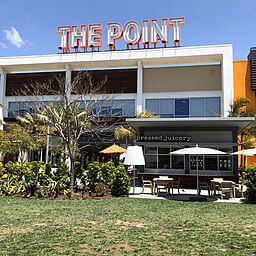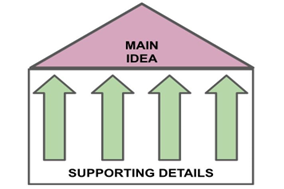Chapter 13: Main Ideas
Figuring out the author’s topic and main idea is the key to reading comprehension. We can also learn to recognize the supporting details which help explain, clear up, or support the main idea. With practice, we can improve both of these skills and get more out of what we read.
What is the topic?
The topic is the central message of a passage. It is a word or phrase which tells the subject of the passage. It tells what the text is mostly about in a general sense and helps the reader understand the overall direction or purpose of the content.
Example
A paragraph with the main idea or topic sentence, “Recycling helps reduce waste, saves energy, and protects the environment,” the topic is recycling.
MAIN IDEA = TOPIC + POINT
What is a Main idea?
The main idea is the one big idea the author wants us to understand in each paragraph. The whole paragraph is there to help us fully understand this one thing. Every time there is a big new idea the author wants to make clear, they write a new paragraph. In writing, the main idea sentence is sometimes referred to as the topic sentence. In longer passages, the main idea is referred to as the thesis.
One definition of a main idea is that it is the topic of the paragraph plus the point the author wants to make about that topic.
MAIN IDEA = TOPIC + POINT
How is the main idea like a roof?
- It is wide and broad enough to cover the rest of the house. In the same way, the main idea is more general than most of the other sentences. It is broad enough to cover the details.
- It has a point. The main idea is the most important point the author is making in each paragraph.
- A roof needs a lot of support, just as the main idea needs support from the rest of the details in the paragraph.
How is the main idea like the destination on a map?
- The destination is the reason, or point, for using a map. In the same way, the main idea is the reason why someone wrote the paragraph.
- Just as it would be difficult to reach a destination without a detailed map and clear directions, identifying the main idea of a passage requires knowing the topic and analyzing supporting details to provide context and clarity.
Finding the Main Idea
Just like there are strategies in solving math problems, there are several strategies for finding the main idea as you read. These strategies will make you better at finding the main idea while also helping you stay focused on the most important elements of the reading.
Strategy #1: Start with the topic of the paragraph.
- In one or two words, predict what the paragraph is going to be about. This is the topic. Often, writers repeat the topic several times, so just glancing through the reading will alert you to the topic.
- Another way to think of a topic is to think of it as a title. If you were to label the paragraph, what would your one- or two-word title be? In fact, putting a title on paragraphs as you read complicated or important material is a great strategy to stay focused on the topic the author wants to explain.
What is the topic of each of these sentences? Choose 1-3 words from each sentence which tell what the sentence is about in very general terms.
- My summer vacation went by too fast.
- I turned my taxes in on time.
- When registering for classes, be sure to pay attention to the course hours and the modality they are offered in.
- My teacher says the craziest things during class.
What is the topic of this paragraph? Look for words that are repeated. The topic would also make a clear title for the paragraph.
When one hears the term “reality” applied to a show, one might expect that the events portrayed occurred naturally or, at least, were not scripted. This is not always the case. Many reality shows occur in unreal environments, like rented mansions occupied by film crews. Such living environments do not reflect what most people understand to be “reality.” Worse, there have been accusations that events not captured on film were later restaged by producers. Worse still, some involved in the production of “reality” television claim that the participants were urged to act out story lines premeditated by producers. With such accusations floating around, it’s no wonder many people take reality TV to be about as real as sitcoms.
Strategy #2: Pay attention to any clue words 🔍
Clue words are red flags which often alert us to main ideas and their supporting details. Writers often use such words to help us notice their main ideas, as well as help us zoom in on specific supporting details. Keeping an eye out for such clues can keep us from missing important information.
A collective amount (something more than one) plus a plural noun is a clue that we have likely found the main idea sentence. They are also know as list words.
As seen in the following examples, these words alert us that the idea in the sentence is general, and a list is coming. These clue words also give us a map of what the supporting details will be.
- There are several helpful steps to managing a panic attack.
- We have three options for dinner tonight.
- I have developed a few time management strategies to keep me from procrastinating.
What are the clue words to the main idea in these sentences?
- The Arizona Cardinal’s rough football season is undoubtedly the result of a series of poor management decisions.
- While English and Reading classes have much in common, there are a few key differences.
- I came up with five reasons to look for a new job.
🎯CLUE TO THE MAIN IDEA – List Words
Collective Word + Plural Noun
- Several steps
- A list of consequences
- Various options
- A few reasons
- A sequence of events
- Numerous examples
- Many ways
- A couple of unique causes
- Some clear differences
- Five effects
- A number of purposes
- A series of results
Think you found the main idea? Always check!
- Is the statement supported by all of the supporting details in the paragraph?
- Is the statement more general than the supporting details in the paragraph?
- Does the statement include the topic of the paragraph and explain the big idea the author wants us to know about that topic?
Hint
Try turning the main idea into a question. If all of the supporting details help answer that question, you have found it!
Where do we find the main idea when it is directly stated in a paragraph?
The main idea may be anywhere in a paragraph; however, there are three spots which are most common. Paying extra attention to these locations when you read can help you find it.
At the Very Beginning
Often, writers like to state the main idea right away at the start of the paragraph. It is then followed up with supporting details to help make the main point clear.
Example of the Main Idea at the Beginning:
It is important for all eligible US citizens to take advantage of their right to vote. Not only does voting allow individuals to influence the direction of local, state, and national policies, but it also serves as a vital expression of democratic participation. When citizens engage in the electoral process, they help ensure that government representatives are held accountable and reflect the will of the people. Furthermore, voting can impact key issues such as education, healthcare, and environmental regulation, all of which directly affect daily life. In addition, consistent voter participation strengthens the legitimacy of democratic institutions and promotes political stability.
🎯The main idea, or the main point the author is trying to make about the topic of the paragraph, sometimes comes first. Supporting details are then needed to follow up and explain the main idea. These details are more specific and often include examples to help us more clearly picture and understand the writer’s point. The supporting details usually make up the majority of the paragraph. Transition words are often used to help us follow along with these supporting points.
After Introductory Detail(s)
Have you heard of a hook? It is quite common for writers to lead into the main idea by introducing the topic with some background information. These introductory details are not very important to the point of the paragraph. Instead, they prepare the reader by activating background knowledge we may already have on the topic or by sharing something that may pique our interest in learning more about the topic. The introductory detail may even state something we already know, or something that is not true, just to focus our attention on what the writer really wants us to know in the main idea statement which follows. These introductory details are often just a sentence or two, but they may be longer.
Example of the Main Idea after an Introductory Detail:
In Washington State, the GOP primary was once decided by only 1 vote. In Baltimore County, in 2018, the Democratic primary was decided by only 17 votes. It may not always seem like it, but it is important for all eligible US citizens to take advantage of their right to vote. Not only does voting allow individuals to influence the direction of local, state, and national policies, but it also serves as a vital expression of democratic participation. When citizens engage in the electoral process, they help ensure that government representatives are held accountable and reflect the will of the people. Furthermore, voting can impact key issues such as education, healthcare, and environmental regulation, all of which directly affect daily life. In addition, consistent voter participation strengthens the legitimacy of democratic institutions and promotes political stability.
The first few sentences may be introductory details. Introductory details are not always needed, but they serve to introduce the topic to us. 🎯The main idea, or the main point the author is trying to make about the topic, often comes next. Supporting details are then needed to follow up and explain the main idea. These details are more specific and often include examples to help us more clearly picture and understand the writer’s point. The supporting details usually make up the majority of the paragraph. Transition words are often used to help us follow along with these supporting points.
At or Towards the End
It is very important to refocus our attention on the ends of paragraphs. Writers sometimes start paragraphs with supporting details and build up to their main idea at the end. When they do this, it sounds like they are “summing up” the paragraph. The writer may include a helpful transition at the start of the last sentence to alert us that they are stating their main idea at the end.
Example of the Main Idea at the End of a Paragraph:
In Washington State, the GOP primary was once decided by only 1 vote. In Baltimore County, in 2018, the Democratic primary was decided by only 17 votes. Not only does voting allow individuals to influence the direction of local, state, and national policies, but it also serves as a vital expression of democratic participation. When citizens engage in the electoral process, they help ensure that government representatives are held accountable and reflect the will of the people. Furthermore, voting can impact key issues such as education, healthcare, and environmental regulation, all of which directly affect daily life. In addition, consistent voter participation strengthens the legitimacy of democratic institutions and promotes political stability. As you can see, there are several reasons eligible US citizens should take advantage of their right to vote.
Sometimes a writer starts with supporting details. These supporting details may include specific examples or stories. Transition words are used to help us follow along and recognize the supporting details. These details build on each other and lead us to the writer’s main point. 🎯 The writer then sums up what these supporting ideas illustrate by stating the main idea sentence at the end.
How do we find the main idea?
Media Attributions
- The Point (El Segundo, California) © Fastily is licensed under a CC BY-SA (Attribution ShareAlike) license
- garlic



